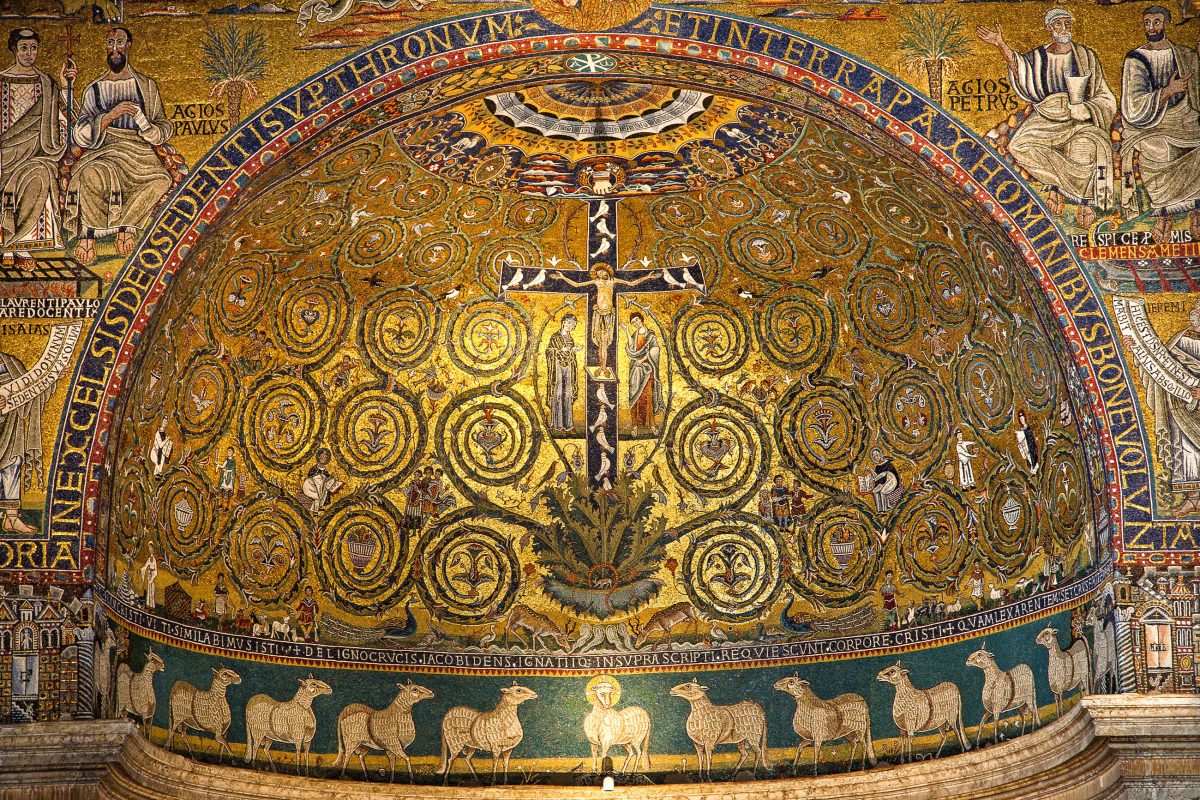Die Kirche San Clemente in Rom in der Nähe des Kolosseums beeindruckt mit einem kunstvoll geschmückten Altarraum und wertvollen Marmorverzierungen im Fußboden der Oberkirche. In der verborgenen Unterkirche sind weitere uralte Fresken zu entdecken.
Viele Gebäude des antiken Rom wurden im Lauf von zwei Jahrtausenden durch Kriege zerstört oder Erdbeben verschüttet und schlummern heute unsichtbar unter den Grundmauern der Bauten des neuen Roms. Eine derartige unterirdische Kirche befindet sich in Rom etwa 10 Gehminuten östlich des Kolosseums.
Die Kirche San Clemente ist aufgrund ihrer horizontalen Zweiteilung in eine Unterkirche und eine Oberkirche eine bemerkenswerte Sehenswürdigkeit. Sie steht auf der Liste unserer Top 10 Sehenswürdigkeiten von Rom und zählt zu unseren 10 schönsten Kirchen Europas.
Die Kirche San Clemente war früher ein Wohnhaus, unter dem sich im 2. Jahrhundert nach Christus ein Heiligtum des Mithras-Kultes befand. Im Jahr 385 wurde darüber die Kirche des Heiligen Clemens, dem dritten Bischof Roms nach Petrus errichtet, die heute noch als die so genannte Oberkirche zu besichtigen ist.
Imposantes Innenleben der San Clemente

Beeindruckend ist vor allem der Altarraum, der mit kunstvollen Mosaiken und Wandmalereien verziert ist. In der Mitte sind die zwölf Apostel als Schafe dargestellt, die sich um das Lamm Gottes gruppieren. Das imposante Gewölbe über dem Altar stellt den Himmel und das Universum dar. Der Lebensbaum streckt seine verschlungenen Ranken bis unter die Kuppel, zwischen denen auch heidnische Figuren, wie zum Beispiel ein Delfin, zu sehen sind.
Die Decke der Oberkirche von San Clemente wird von antiken Säulen gestützt, im Marmorfußboden, in den Chorschranken und im Osterleuchter sind kostbare Kosmatenarbeiten eingelassen. Der italienische Maler Masolino hinterließ der Nachwelt einige herrliche Renaissancefresken aus dem Jahr 1431 am Anfang des linken Seitenschiffs.
Abstieg in die Unterkirche von San Clemente
Während der Eintritt in die Oberkirche kostenlos ist, ist für den Zugang zur antiken Unterkirche aus dem 4. Jahrhundert ein Obulus von ein paar Euro zu entrichten. Steigt man die etwa 30 Stufen in die Unterkirche hinab, wird man von feuchter, modriger Luft empfangen.
Zu sehen gibt es neben verwinkelten dunklen Gängen wunderbare jahrhundertealte Fresken an den verwitterten Steinmauern. Teilweise verblichen aber doch noch zu erkennen, stellen sie religiöse Szenen, wie die Hochzeit von Kanaan, die Auferstehung Christi oder die Mutter Maria dar.
Auch vom Mithras-Kult ist ein beeindruckendes Relief übrig geblieben. Der gottgleiche Mithras schneidet auf der Abbildung dem Urstier die Kehle durch, während Hund und Schlange sein Blut auflecken und ein Skorpion aus den Hoden des Stiers den Samen für die Erschaffung der Welt entlässt.
Die gleiche Szene wird auch von einer Statue im Vatikan-Museum dargestellt. Bei spärlicher Beleuchtung am unterirdischen Ursprungsort seiner Entstehung vor knapp 2.000 Jahren ist die Darstellung jedoch um einiges eindrucksvoller anzusehen.





